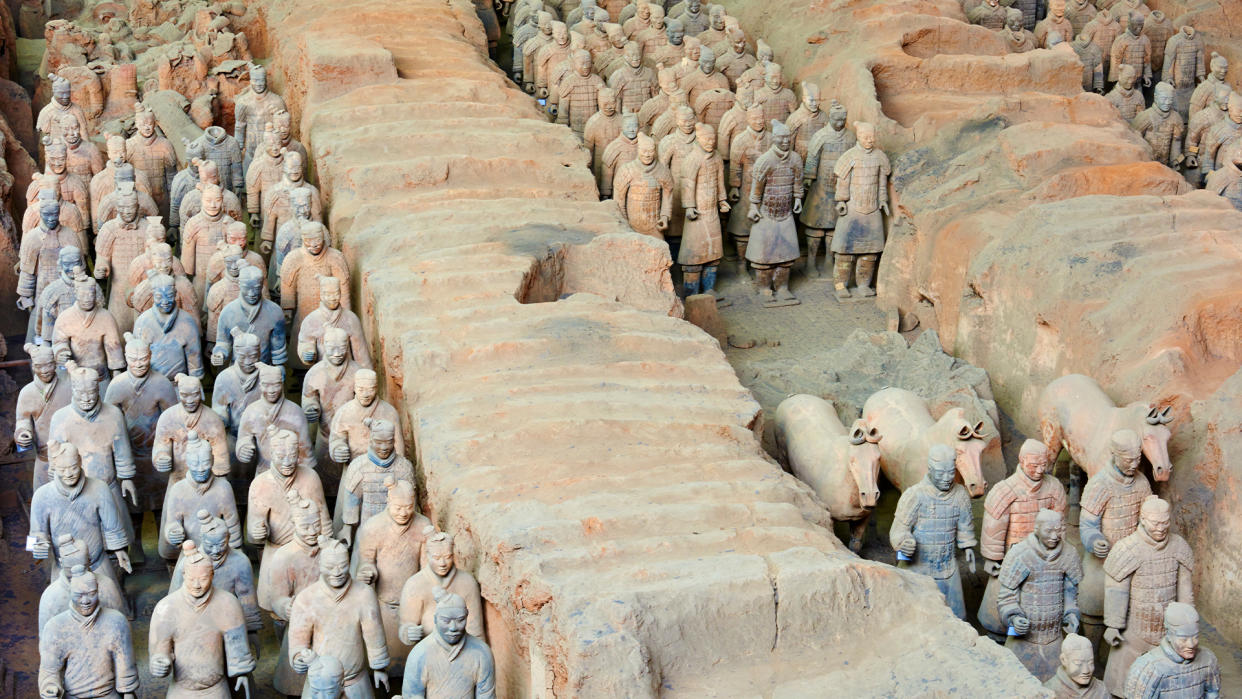Remains of 2,000-year-old sheep-drawn chariot discovered near 'Terracotta Army' in China

- Oops!Something went wrong.Please try again later.
Archaeologists have discovered the remains of what appears to be an ancient sheep-drawn chariot near the famous "Terracotta Army" in northwestern China.
The English-language website China Daily, which is owned by the Chinese Communist Party, reported that the remains were found in the "western tomb" at the site of Emperor Qin Shi Huang's mausoleum, a few miles northeast of the city of Xi'an in Shaanxi province.
Archaeologist Jiang Wenxiao, who is leading the excavations of the tomb, told China Daily that the main structure of the chariot had rotted away after spending more than 2,000 years in the ground. (The mausoleum dates to the third century B.C.)
But the team did find a row of six sheep skeletons wearing accessories used for pulling a chariot, so they inferred this was a sheep-drawn chariot, Wenxiao said.
Drawn by sheep

Horse-drawn chariots and ox-drawn carts were common in ancient China, but a sheep-drawn chariot is an extremely rare find, Wenxiao said.
They appear in Chinese history, however, as well as in Chinese lore. The founder of the Western Jin dynasty, Emperor Wu (or Sima Yan), who ruled from A.D. 266 to 290, is said to have ridden in a sheep-drawn carriage around his palace complex every night and would sleep wherever the sheep stopped.
His practice may be the origin of the modern Chinese phrase "seeking luck in a sheep cart"; it's said the emperor had a harem of 10,000 wives, and this seems to have been Sima Yan's method of choosing among them.
Wenxiao presented the discoveries at the Fourth Congress of Chinese Archaeology, which was held in Xi'an in October, according to the state-owned website ECNS.cn.
The team hopes laboratory analysis on the western tomb's burial chamber, which is currently underway, will help them determine who was buried there, the report said.
Chinese chariots

In addition to the six-sheep chariot, archaeologists unearthed a four-wheeled wooden chariot, presumably drawn by horses, equipped with an ornate rectangular umbrella. It is the oldest of its type ever found, according to Wenxiao.
They also found a wealth of copper chariot and horse-related artifacts, as well as iron tools and copper weapons, providing new insight into the period when iron tools first began to appear.

RELATED STORIES
—Sacrificial pits filled with 120 horse skeletons found in Bronze Age city in China
—Complete Bronze Age town with elite tombs discovered in northern China
—Dozens of centuries-old stone grenades from Ming dynasty discovered at Great Wall of China
The mausoleum of Emperor Qin Shi Huang, who ruled from 221 to 210 B.C. and is considered the first emperor of a united China, is spread over about 10 square miles (26 square kilometers) and took 38 years to complete. Three immense pits in the mausoleum site hold more than 8,000 life-sized sculptures that depict the emperor's soldiers and their horses — the so-called Terracotta Army.

